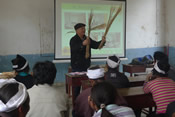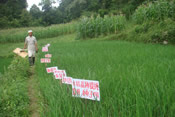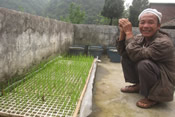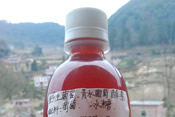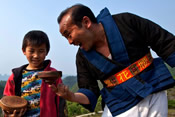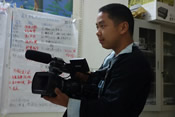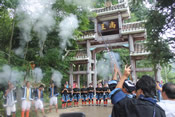
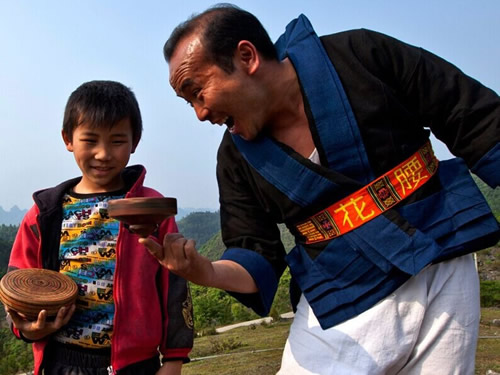 |
| He Guangbing teaching students how to play spinning tops. (Wang Jian) |
By Zhan Yuping (Programme Manager for Guangxi, PCD); PCD Editor
Since I joined PCD again and assumed responsibility for the Guangxi Programme in early 2013, I have been following up on the programme of sustainable living of the Baiku Yao community in Lihu Township of Nandan County, Guangxi Province. The programme aims to support the community’s effort to preserve their national culture in the face of modernisation and urbanisation. Three years have elapsed. I have witnessed the changes in the community and how, with PCD’s support, the community strives to practice a sustainable way of living. I have a lot of admiration for the wisdom and resilience of the Baiku Yao community. That is why I want to document the changes that is taking place in the community, as well as the joys and tribulations, accomplishments and hardships that they experience in their struggle to maintain a sustainable way of living.
In the beginning, PCD rented a simple flat in Lihu Township to set up a programme office to implement the programme, which was a collaboration between PCD and Guangxi National Museum. In those days, Lihu was no different from most remote villages and towns. When I visited the programme site with my colleague and our partner, we stayed in an old and shabby guesthouse. It was the only guesthouse in Lihu and most of the time we had to take showers with cold water.
The community’s ambivalent feelings on improving material life and preserving cultural heritage
In the Baiku Yao community, many people have been striving with utmost effort to preserve the endangered national cultural heritage while looking for means by which cultural conservation and development may coexist. In a work trip to Lihu when I just started to work for PCD again, I met quite a few people who were adamant about practicing and passing on ecological farming as the community was increasingly coming under the influence of agricultural modernisation. I took part in a year-end exchange meeting organised by Director Mo, a retired cadre of the county’s agricultural department, who was responsible for the department’s work on ecological agriculture. The purpose of the meeting was to bring together farmers to exchange experience on cultivating ecological rice over the past one year and result of their experiment in growing new varieties of rice. Director Mo did not speak the Yao language and was speaking in the Guiliu dialect. I could not forget watching him introducing the output of different varieties of ecological rice while villagers wearing white trousers and their heads wrapped in white scarfs listened. All the posters about ecological agriculture were drawn by Director Mo himself. On the posters he had marked where and when the rice samples were taken. I was amazed how scrupulous he was. We also visited Li Youming, an ecological farmer, to look at the paddy seeds he had been saving and to watch a short video he made himself about his experiment in ecological agriculture. However, in the meantime, Li Xia, staff of Baiku Yao Ecological Museum which was set up with the support of Guangxi National Museum, told us that even though their village was located in the zone that the museum was seeking to preserve, an increasing number of cement houses were being built and there were less and less traditional houses. The museum’s philosophy of “protecting and preserving the genuineness, wholeness and indigenity of the cultural heritage (of Baiku Yao) on a village by village basis” was being undermined by internal as well as external factors.
Efforts and setbacks in preserving and passing on Baiku Yao’s cultural heritage
Villagers’ efforts in the face of modernisation and setbacks as mentioned above continued interminably. A year later, when we were doing our final evaluation of the programme, Director Mo told me apprehensively that villagers were becoming less enthusiastic about ecological agriculture and it was getting more difficult to accomplish the goals of the programme. One main reason was that they had focused too much on experimenting ecological wet paddies. Even though the two-year experiment showed that rice could be cultivated and harvested without using pesticide or chemical fertiliser, the yield was less. Since the size of the plots that villagers were cultivating were not big, they lost confidence in growing ecological rice. The villagers had got some conventional varieties of rice from Rice Research Institute of Guangxi Academy of Agricultural Sciences and from visits to farmers in other counties and provinces. The conventional rice varieties were drought-tolerant, pest-resistant and tolerant of poor soil. Even though they were suitable for local cultivation, their yield was less than hybrid rice. That was why only a few farmers were willing to continue to cultivate ecological water paddies. Uncle Youming, who was in his fifties, was enthusiastic about growing ecological rice. To mobilise the villagers, Director Mo had called a number of meetings but to no avail. Uncle Youming was the only one who was willing to continue with the endeavour.
Among the cultural conservation programmes that PCD supported, one programme involved supporting He Guangbin, a teacher at Huai Li Primary School, to pass on the culture of spinning tops. The teacher was passionate about literature as well as his own traditional culture. In his memory, Baiku Yao boys love to play spinning tops since they were small. Everyone—young and old—played spinning tops. During New Year and other festivals, the men of every village gathered for spinning top competitions which were spectacular sights. He himself was crazy about spinning tops since he was a kid. However, he noticed that in the last 20 years, as more and more people left to work in cities and in other provinces, fewer and fewer villagers played spinning tops and children have increasingly lost their interest in such a game. He felt bad, and in about 2008, he began to explore new tricks in playing spinning tops in the hope that it would arouse the interest of children. After much study, he created a new trick and began to teach it to children in his PE class. Apart from giving him support in purchasing simple tools for teaching spin tops, PCD also facilitated his visits to Yunnan and Jinchengjiang to have exchange with other teachers on their experience in teaching local rural culture in school.
However, He Guangbin was the only teacher in his school to teach students to play spinning tops, and he was teaching it in his own class only. After a few years of practice, he had become a well-known spinning top player and was often invited to perform together with his students. Apart from this, his effort in preserving and passing on Baiku Yao’s cultural heritage in teaching had not won him recognition or imitation. He Guangbin was transferred from Huai Li Primary School in 2014, and there was no more class for students to learn to play spinning tops.
The incessant impact of the development of tourism
The Baiku Yao community has been faced with one challenge after another. In 2014, the local government began to develop tourism on a large scale. For a start, tens of millions of yuan were invested into rebuilding Lihu into Lihu Baiku Yao Folk Town. The exterior walls of all the houses of Lihu, a town inhabited by a national minority, was painted light yellow while the roofs were rebuilt in the Anhui style, a traditional Han architectural style. A cultural square with a waterwheel was built, surrounded by a few newly constructed traditional barns. Envisioning a bright future brought by tourism, two guesthouses and three new restaurants were opened in the town.
In addition, a local businessman with capital invested heavily in building “Geyasigu Valley—the Chinese Baiku Yao Folk Custom Area”. The local government had built a village near Ganhe imitating traditional Baiku Yao village for tourists. However, it remained mostly unused since it was built. Now in the same location there is a hotel built of rammed earth the minimum room rate of which is 499 yuan per night. In Wangshang, a village that was accessible from the tourist area only by way of natural karst caves, all old houses were rebuilt in about 2009. Since then, the village has been undergoing a new round of development. A wide cement road was built connecting it with and turning it into a part of the tourist area. Villagers are employed to display their traditional craft of embroidery, to play bronze drums or to work as security guards in tourist spots.
Development of tourism has attracted flocks of tourists. Every year in the sixth month of the Chinese lunar calendar when the local people celebrate the festival of Xiaonian, the town is jam-packed with tourists. The same happens in the New Year market that opens in the first month of the lunar calendar. Local youngsters told me that the New Year market used to be filled with folks from nearby villages, who were there to sing ancient songs, join bird or cock fights and spinning top competitions. Most of the visitors of the New Year markets were local people who had come on their own initiatives. In recent years, market events have become performances and participants are employed to go there to play spinning tops, sing ancient songs, display their craft of embroidery, and to do cock fights, etc.
Some unethical travel agencies have been enticing tourists by vulgarising Baiku Yao women’s costumes in their advertisements. More and more novelty-seeking tourists are snapping cameras at villagers without their consent. Villagers, who are enraged by the behavior of the tourists, sometimes threaten to break their cameras, while some villagers demand for money. In some instances, villagers are asked to perform the custom of bull-slaughtering. For Baiku Yao, slaughtering bulls is a sacred custom performed only in a funeral. Many feel that the demands of tourists have gone too far and they feel that outsiders have crossed the bottom line of the Baiku Yao community.
Strengthening the awareness for cultural preservation: development of tourism as a double-edged sword
Faced with the development of tourism, how to preserve and pass on their culture and traditions becomes a hard question that Baiku Yao from all walks of life want to address.
A group of young people at the Lihu Baiku Yao Ecological Museum had set up the “Society of Rural Culture” to preserve and pass on the culture of Baiku Yao and many Baiku Yao joined. In 2011, it was officially registered as Association for the Preservation and Development of Baiku Yao Folk Culture in Nandan County (“Association” hereafter). In the beginning, the Association conducted cultural research and documentation aiming at publishing a book series on the history and culture of Baiku Yao. However, in the course of writing the book series, they realised that they were confronted with the problem of a dramatic break in their culture which was under pressure from both inside and outside. It was of course important to document Baiku Yao’s culture, but what was more important was to help young people to understand and learn traditional culture in their everyday life and not having them reminiscing their traditional culture from books after it was gone. Subsequently the organisation and PCD joined hands to explore ways to preserve and pass on the culture of Baiku Yao. Lu Chaojin, the secretary-general of the Association and who was quite knowledgeable about the culture of Baiku Yao, was worried. “The culture of Baiku Yao is extensive and profound. In my study of our ancient songs, I have found that there is a connection between the origin of Baiku Yao and what was described in San Hai Jing (Classics of Mountains and Seas), but few young people knows and understand ancient songs now. If we, the middle-aged people, did not act as the bridge and encourage the elderly people to teach the young people, there would be a break in our history and culture,” he said.
Young people use visual images to reflect on contemporary life and local culture
Apart from the Association, we must also mention a young force—a group of Baiku Yao youths who are passionate about filming. They have been documenting the life in their village and recent changes and exploring the value of the traditional culture. About a dozen young people have joined the group, Baiku Yao Youth Visual Images Group.
In the beginning, the young people were only interested in using the camera. After they had acquired the basic skills in filming, they began to record their everyday life even though the filming did not have any specific purpose. Some of them only wanted to do their first film. Their unsophisticated films were shown in a few film festivals and during exchange visits—enough to win them recognition and encouragement. Since then their interest in doing documentary films have grown. They have also become more aware of the power of visual images as tools of self-expression. Later the young people began to think about how they can strengthen their interaction with the community. This year in the New Year Market Festival, with the support of the Association, the youth group organised the first Baiku Yao Rural Village Photos Exhibition and Film Show during which documentaries made by the youth group were shown not only in Lihu, but also in various local communities. Villagers were very enthusiastic and lingered on till midnight after the film show.
During the course of filming, the young people began to reflect more on their everyday life. For example, He Wenbing, who belongs to the post 90s generation and a father of two children, notices that more and more herbicides are being used in the fields, and disposable bowls and chopsticks are becoming more popular in banquets. The documentaries they filmed have never addressed the issue of ecology and environment. This year after the New Year Market Festival, the square was filled with garbage. He was very concerned and decided to apply for funding from the Creating Green Home Project Fund of Society of Entrepreneurs and Ecology (SEE) Foundation so that he may make a film to arouse the community’s awareness of environmental issues. He also wants to encourage young people in the community to learn ecological farming from Uncle Youming. He Wenbing has only finished junior high school. It was the first time for him to write a proposal and to sit for an interview. “No matter what, it is a learning opportunity. Whether I get the funding or not, I am going to do it,” he said. Other members of the youth group are also planning their own film projects, the themes of which include village relocation, family history, costumes and plants, ancient songs, etc.
New hopes in the face of setbacks during the course of cultural heritage conservation
The path of cultural heritage conservation rises and falls, but in the face of setbacks there are new hopes. With resolution the Baiku Yao community stumbled on. There are obviously a lot of difficulties in pursuing ecological farming, but so long as someone persists, there is hope. Even though most villagers have given up, Uncle Youming continues to explore ecological agriculture. Influenced by the programme supported by PCD, he has been studying ecological farming skills and methods over the years. Whether he is conducting experiment to compare different varieties of water paddy or doing test on hybrid rice, he is scrupulous. He collected over 20 conventional varieties of water paddy through exchanging seeds with other farmers and on study trips. Every year he screens and rejuvenates the varieties of water paddy he has collected. “I don’t care if the yield is high or low. I will continue to save the seeds. Who knows when would there be a natural or man-made disaster? You have control only when you have the seeds,” he said. Recently he has come up with an idea of setting up a family seed bank. He wants to turn his home into a community learning centre for ecological agriculture. Li Minghua, his nephew, follows his example. Instead of going to work in the city, Li Minghua stays home this year and learns ecological agriculture with his uncle. Some young people in Huaili Village also want to try to grow maize this year using only home manure.
Thanks to the advocacy work of the Association and encouraged by the curriculum reform initiated by the education department, Yeung, the headmaster of Lihu Secondary School, who has taken up the position only for two years, is aware of the importance of teaching their national culture. He decided to make teaching national culture of Baiku Yao a focus in the new curriculum. This year, with the support of the headmaster, the Association and the Bronze Drum Literary Society of Lihu Secondary School co-organised the National Culture Essay Contest. Over 500 essays have been submitted by the students. Because of the essay contest, many teachers and students become concerned about and interested in their national culture. Meng, the teacher responsible for the activity, was very happy with the result. “Next year I am going to open the contest to everyone in the community and not limit it to secondary school and primary school students,” he said with confidence. Thanks to the initiative and support of Tan, the headmaster of Lihu Central Primary School, now every village primary school has spinning top lessons. In Huaili Primary school, where spinning top has not been taught for the last few years, a class will be opened this year. He Guangbin’s students are now teaching students how to play spinning tops. “We’ve won the first prize in group competition in the spinning top contest held in March Third Central School and second prize in performance,” a PE teacher who teaches spinning tops told me excitedly.
In addition, the teachers of Huaili Primary School, who have been giving costumes making lessons in the school, are going to organise costumes making classes in the village and national costume makers in the village will be teaching. “I don’t think the kids would be able to make costumes after only a few lessons. After all it takes us years to learn it. But I believe that their interest in making costumes would be aroused and they can go home and learn it from their mothers. In this way we can pass on the craft of making our national costumes and only when we put on the costumes we make ourselves will we have pride in ourselves,” said Li, the female master.
Guided by the “secret codes” of their national civilisation, the Baiku Yao community strides on
Baiku Yao is a branch of the Yao nationality. Even though there is only a population of 30,000 people, its culture has been kept intact, thanks to the resilience of the community which is truly amazing and admirable. As an outsider, I have not been able to grasp their wisdoms. I believe that there must be some kind of “ secret codes” in their national civilisation, but it is not important whether outsiders understand these codes. So long as the community can pass them on generation after generation, they would certainly be able to persist and to stride on in the face of blows brought by the unprecedented modernisaton and urbanisation. I am happy to see that a team to preserve their cultural heritage consisting mainly of young people but also with the participation of elderly and middle-aged people is being formed. Even though initiatives to preserve and pass on their cultural heritage are now scattered and isolated, I believe that collaboration between different generations of Baiku Yao would gradually bring about a harmonious relationship between the community and Nature and between the community and the larger society.


